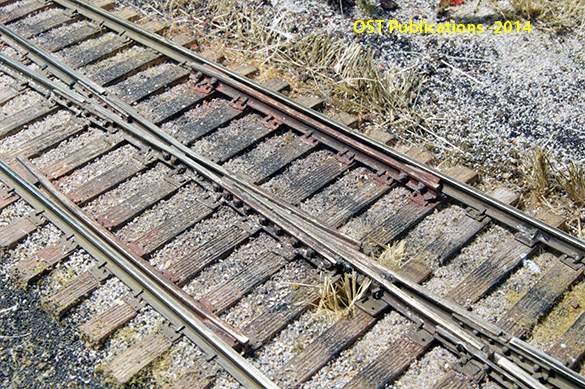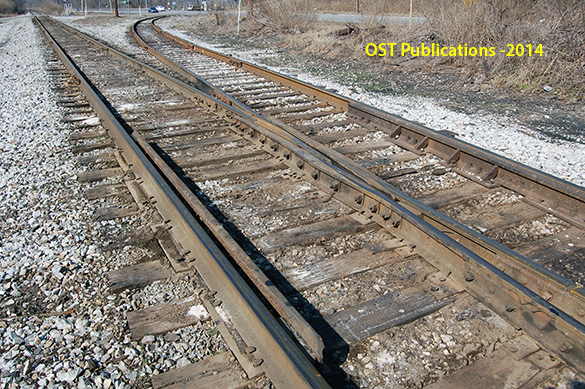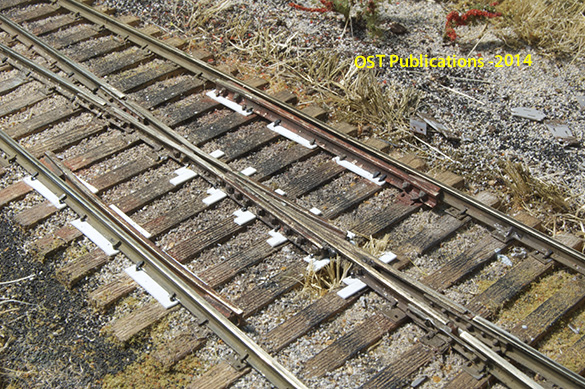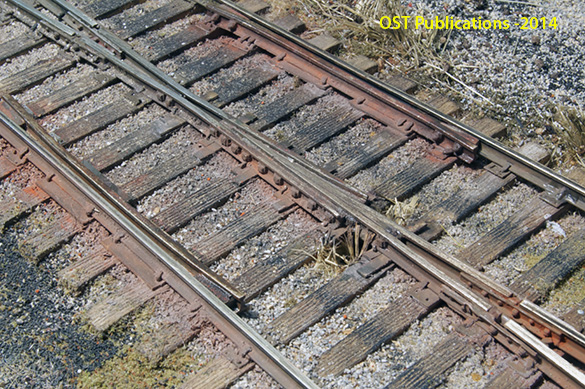More than a few people have complimented the track work on the I&W (above) and I appreciate receiving such comments. However, compliments aside, a closer study of the prototype reveals areas that could be improved and the turnout details are one of them. In looking at photos of the junction turnout at Valley (below), I noticed several details that would be simple to add without turning it into a major project.
A close look showed hook tieplates under the frog along with elongated tieplates that span two ties under the guardrails. When laying this track I used generic plastic slide plates from Right-O-Way. There’s nothing wrong with these but they don’t match prototype practice. Making more accurate pieces is a simple matter of cutting some strip styrene.
Hook tieplates come in several lengths ranging from 23, 27 and 31 inches. They’re used in offset pairs under frog castings in place of regular tieplates. I made mine from 0.020″ thick by 0.080″ wide Evergreen styrene strip. I did not remove the frog. I was able to pull the spikes from the existing tieplates and slide them out from under the casting without a problem. I cut new 23 inch long hook plates, placed them into position and replaced the spikes to secure the frog.
To make the tandem tieplates (I don’t know what else to call them) under the guardrails I used two pieces of 0.020″ thick by 0.188″ wide Evergreen strip. I needed two pieces to get the proper width. It so happened that a scale 27 inch length perfectly spanned two ties. A piece was fitted from both sides of the rail with the seam hidden under the guardrail casting. Because the turnout at Valley is longer than my No. 10, the guardrails are also longer and of a different design from the American Switch and Signal castings that I use. Due to the shorter guardrails, I only needed three tandem tieplates instead of the four used at Valley. This looks a bit odd and as you can see in the final image below, I removed the outer most tieplates and just went with two tandem plates under each guardrail. It isn’t perfectly accurate but is to my satisfaction.
After everything was back in place, I touched up the raw styrene with paint and chalk dust. The total time involved was around three hours, which included looking through my photo archives, making an 8×10 print to have on hand for reference, researching the various material sizes needed and doing the work. The project didn’t involve relaying any track.
You can learn more about modeling prototypically accurate track in Detailing Track, a 125 page, softcover book along with volume 07 of The Missing Conversation, my digital only quarterly publication.
Regards,
Mike




Nice work, Mike. I showed the final picture, plus the prototype shot, to a colleague at work. He didn’t understand why, until the penny dropped and he said, “Oh, is one of them a model?” He didn’t know which, though.
That simple paint and chalk technique seems to have nailed colour and texture.
Simon
Thanks Simon. There’s no rhyme or reason to the paint/chalk dust technique. I apply the chalk dust while the paint is still wet and blend with a wet brush if needed. This produces a nice gritty but dry looking texture. Sometimes I just dust the dry surface to tone down any excess shininess.
Mike